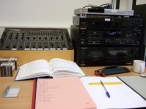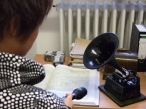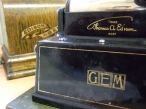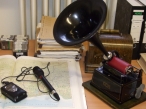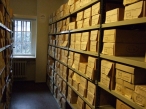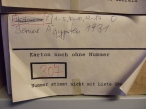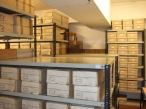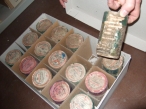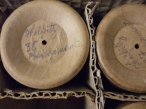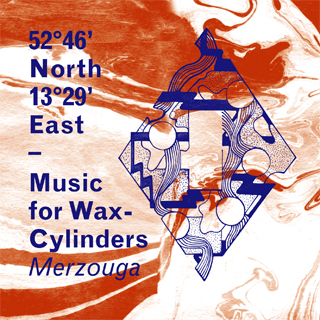
52°46’ North 13°29’ East – Music for Wax-Cylinders | Merzouga
Gruen 124 | Audio CD > [order]
The World’s Most Moveable Armchair
Erich Moritz von Hornbostel was an „armchair ethnologist“. Due to his bad health the musicologist was unable to travel to faraway countries. Instead he sat at his desk in the Dorotheenstraße in Berlin and received the world through his phonograph. On from 1900 the world’s music arrived at his office in the form of more than 16.000 wax-cylinder recordings from all over the planet. Due to an edict by the Prussian Emperor all German trading as well as scientific expeditors were bound to travel with a phonograph and send their recordings to Berlin. Today we might put it that way: Hornbostel was in charge of the biggest field-recording project of all times.
In his case being a stay-at-home was definitely an achievement. His immobility gave Hornbostel the chance to develop a completely new perspective, an unprecedented acoustical bird’s eye view, and made him the founder of a new discipline: comparative musicology’s aim was to “unveil the dark and distant past (…) and to extract the timeless and the general from the abundance of our present; in other words: We want to get to know the historic and the basic esthetic principles of musical art.” (1)
Approximately 100 years later Hornbostel’s acoustic present has itself become a dark and distant past. To our ears the 16.000 wax-cylinder recordings of the Berlin Phonogram-Archive sound like treasures from a long lost world. These treasures are not only raised by researchers but increasingly also by artists. The current archive’s management is generously granting them access to the recordings that have been digitalized over the past fifteen years.
Thus Eva Pöpplein and Janko Hanushevsky (aka Merzouga) have become fellow armchair-travelers. They bring along a lot of experience, which they collected as heavy-duty field-recordists on intensive sound-expeditions through India and South-East-Asia. („Good Morning, Rickshaw“ – Deutschlandradio Kultur 2008; „Mekong Morning Glory“ – Deutschlandradio Kultur 2009 / Gruenrekorder 2011). Now they encompass the sonic landscape of the Phonogram-Archive with the same musical sensitiveness that can be found in their previous works. Just like Hornbostel the two are genuinely interested in something timeless, something general: the uniquely beautiful human ability to play with sounds and structures. Janko Hanushevsky integrates his electric-bass improvisations into the historic wax-cylinders’ cracks and scratches. And Eva Pöpplein sparingly applies electronic effects in order to distill precious essences from the sonic material.
The result is a musical position-reckoning between the past and the future of sound-recording: Located at 52°46’ North and 13°29’ East, in the Ethnologisches Museum Dahlem, is the world’s most moveable armchair.
Marcus Gammel, Deutschlandradio Kultur
(1) Erich Moritz von Hornbostel: „Die Probleme der vergleichenden Musikwissenschaft“ (1905) in ders.: Tonart und Ethos, Leipzig 1986, S. 56
In our composition we worked with historic wax-cylinder recordings from the following collections (In alphabetical order):
Archiv Ungarn
Collector: Hornbostel, Erich M. v.
Places of recording: Berlin
Year: 1905
Region: Hungary
Berner Ägypten
Collector: Berner, Alfred
Places of recording: Delta, Gize, Kairo
Year: 1931
Region: Egypt
Gusinde Feuerland
Collector: Gusinde, Martin
Places of recording: Canal Smith, Mejillones, Munoz Gamero, Remolino
Year: 1923
Region: Tierra del Fuego
Helfritz Jemen
Collector: Helfritz, Hans
Places of recording: unknown
Year: 1930-1931
Region: Hadhramaut (Yemen)
Kaschke Abbessinien
Collector: Kaschke, Erich
Places of recording: Axum
Year: 1906
Region: Abyssinia
Kunst Bali
Collector: Kunst, Jaap
Places of recording: Oeboed, Siekawati
Year: 1925
Region: Southern Bali
Leber Samoa
Collector: Leber, Alfred
Places of recording: Amoa, Fagamalo, Mulinu
Year: 1911
Region: Samoa
Meier Schweiz
Collector: Meier, John
Places of recording: unknown
Year: 1906
Region: Central Switzerland
Preuss Mexico
Collector: Preuss, Konrad Theodor
Places of recording: Jesus Maria, a small village in the Sierra Madre
Year: 1906
Region: Mexico
Weiss Südchina
Collector: Weiss, Fritz
Places of recording: unknown
Year: 1913-1914
Region: Southern China
Weiss Westchina
Collector: Weiss, Fritz
Places of recording: Chengtu, Sezchuan
Year: 1912
Region: Western China
Excerpts:
1 Track (38′42″)
CD (500 copies)
Credits
Merzouga:
Eva Pöpplein (composition & electronics) &
Janko Hanushevsky (composition & prepared electric bass)
www.merzougamusic.com
Recorded live in concert at Alte Feuerwache, Cologne, in autumn 2012.
All electro-acoustic music was composed, produced and performed
by Eva Pöpplein & Janko Hanushevsky.
The historic wax-cylinder recordings of traditional indigenous music were used with kind permission of the Berlin Phonogram-Archive, Ethnologisches Museum, Staatliche Museen zu Berlin – Stiftung Preußischer Kulturbesitz.
Liner Notes by Marcus Gammel (Deutschlandradio Kultur).
Epilogue by Albrecht Wiedmann (Berlin Phonogram-Archive).
Translations by Janko Hanushevsky.
Mixed and mastered by Eva Pöpplein.
Audio-CD released by Gruenrekorder.
Design by Sebastian Ristow, FLATLAB.
Photos by Merzouga.
Artists portrait by Markus Gradwohl.
Merzouga would like to thank
Roland Etzin, Lasse-Marc Riek, the Berlin Phonogram-Archive and SKE-Fonds.
Special Thanks to
Marcus Gammel for the liner notes, Albrecht Wiedmann for his words and his invaluable support at the Phonogram-Archive over the years, Markus Gradwohl, Maike Müller, Franziska Seeberg and Oper Dynamo West for getting us started with the wax-cylinders, Sabine Küchler for inspiring us to continue working with the material, Sonja Harth for being Merzouga’s third ear, Peter Herbert for his friendship and his continuous inspiration, our families for their love and support, and last but not least our two children who have been very patient with us.
We would like to express our gratitude to the men and women whose names have been forgotten, but whose voices can still be heard on the wax-cylinder recordings of the Berlin Phonogram-Archive. We have been privileged to work with YOUR music.
Dedicated to Nicolai.
With kind support of SKE Fonds, austro mechana

Historic wax-cylinder recordings used with kind permission of the Berlin Phonogram-Archive, Ethnologisches Museum, Staatliche Museen zu Berlin – Stiftung Preußischer Kulturbesitz

(P) 2013 Gruenrekorder (C) 2013 Janko Hanushevsky (AKM / austro mechana) & Eva Pöpplein (GEMA). All rights reserved. Unauthorized public performance, broadcasting, hiring, lending and copying of the record prohibited.
Soundscape Series by Gruenrekorder
Germany / 2013 / Gruen 124 / LC 09488 / GEMA / EAN: 4050486098356
IDWAL FISHER – an antimacassar for the hearing
[…] The most radical of the remaining four comes courtesy of Merzouga’s trawl through the 16,000 wax cylinders as belonging to the Berlin Phonogram Archive. Since the early 20th century ‘… trading as well as scientific expeditions were bound to travel with a phonograph and send their recordings to Berlin’. More than a hundred years later the duo of Eva Pöpplein [electronics] and Janko Hanushevsky [prepared electric bass] have taken elements from what I presume is but a small selection of the archive and transformed them into one 38 minute whole.
In his excellent sleeve notes the head of the Berlin Phonogram Archive Albrecht Wiedman asks a pertinent question; ‘Could the archive benefit from such an endeavor?’ But its not until he realises that unlike scientists, who request that the cylinders be digitally restored before embarking on their research, sound artists actually prefer the surface noise and imperfections and wish to incorporate these deficiencies into their own work. It sounds like an epiphany of sorts for Wiedmann who admits that he’s glad he took the opportunity to work with the pair and now listens to the archive from different perspectives.
Merzouga’s skill lies in the way in which they marry their instruments into a world filled with ghostly voices, bird calls, ethnic chanting, and all manner of grime as accumulated in however many of those 16,000 cylinders they worked through. Pöpplein’s electronic treatments are subtle and deftly placed, a ringing here, a quiet drone there, a fallen saucer lid coming to rest. Hanushevsky’s bass meanwhile goes through all manner of permutations from rubbed edges, to tiny plucks to bowed throbs.
What makes the piece work so well is the tempered nature in which the three elements combine. Never during this 38 minute piece do you get the feeling that one element or another has taken over and bossed the show. At times surface noise is left to run alone, chanting tribesmen are backed by a beautiful paced bass run, ancient ceremonies are backed by chiming bowl rings.
Merzouga have graced these pages before with a similarly approach to a trip down the Mekong river. 52 46 North 13 29 East [the coordinates for the Ethnologisches Museum Dahem where these cylinders are stored] is a far more adventurous undertaking and one with far more startling results. In the final second of this piece there lies the familiar sound of a needle full of fluff leaving its groove. A fitting ending but only a temporary one due to continuous plays. […]
link
Hal Harmon | Musique Machine
Gruenrekorder presents 52°46’ North and 13°29’ East – Music for Wax Cylinders by Merzouga. The duo of Eva Poplin and Janko Hanushevsky offer a single track CD utilizing historic wax-cylinders from the Ethnologisches Museum Dahlem in Berlin. Gruenrekorder, an imprint with a penchant for field-recordings, always seems to have an interesting story behind the making of each of their releases. This disc is no exception.
As the story goes, Erich Moritz von Hornbostel was a musicologist who, due to poor health, was virtually homebound. Despite his predicament, he was fortunate to to be put in charge of a massive field-recording project. At edict of the Prussian Emperor during the early 1900’s, all German trading and scientific expeditions were to be recorded via wax cylinders. Over 16,000 of these wax cylinders came under the care of Hornbostel and over 100 years later some of these recordings were made available to Merzouga.
Before delving into the music presented, I must comment on the presentation, which is very top notch. The disc comes in a full-color digipack with a 12 page booklet featuring photos of some of the cylinders used.
52°46’ North and 13°29’ East – Music for Wax Cylinders contains a single 38:42 track recorded live in concert at Alte Feuerwache, Cologne in the Fall of 2012. The duo delivers instrumental passages (predominantly and electric bass guitar and minimal electronics) interspersed with a number of recordings from the wax cylinders. Throughout the piece you’ll find children singing, people speaking, yodeling, chanting, and bands playing, captured on wax cylinders in various countries from around the world. And of course, it goes without saying, that there are copious amounts of wax cylinder surface noise to be found on the recording, which a very much enjoy. The sounds go from being straightly played to being manipulated through delays and other effects. Hanushevsky’s bass interludes are found throughout the piece, which often play out in dense reverberating waves. There’s also a lot of wild string plucking and seeming electro-acoustic parts either coming from the recordings or from one of the duo. It’s hard to tell sometimes. The pairing of the instruments with the recordings makes for a listening experience that goes from jovial to haunting to somber. To be able to see those wax cylinders on stage must’ve have been quite a spectacle.
Another solid release from the folks at Gruenrekorder.
link
Holger Adam | testcard #24: Bug Report. Digital war besser
[…] Weiter geht’s mit MERZOURGA, einem Duo bestehend aus Janko Hanushevsky und Eva Pöpplein, das aus dem Berliner Phonogram Archiv Wachszylinder benutzen durfte, um die darauf enthalten Aufnahmen zu digitalisieren und zu einer elektro-akustischen Komposition zu verschmelzen. Mit wissenschaftlicher Akribie ist diese Zeitreise in die phonographische Vormoderne im Booklet festgehalten. Die Aufnahmen aus den Jahren von 1905 bis 1931 stammen aus allen Ecken der Welt, aus der Schweiz, Samoa, Ungarn, Ägypten, China etc. … Verzeichnet ist, soweit bekannt, wo sie aufgenommen wurden und wann, aber nicht von wem. Dass Janko Hanushevsky und Eva Pöpplein im Booklet den anonymen Urheber_innen der Töne, die sie verwendet haben, danken, kann nicht hoch genug bewertet werden. Es ist vor dem Hintergrund vieler Reissues mit so genannter ethnischer Musik, deren Urheber_innen nie gedankt wird, geschweige denn, dass sie dafür entlohnt wurden oder werden, mehr als eine forschungs-ethische Geste, zumindest zu bemerken, dass man sich Musik nur ausleiht und dafür bedankt, sie benutzen zu dürfen. Das Ergebnis auf 52°46’ North 13°29’ East. Music For Waxcylinders (die Koordinaten sind die des Museums, in dem die Zylinder aufbewahrt werden) ist die Aufnahme eines Live-Konzertes von Merzouga aus dem Jahr 2012, zu dem die Wachszylinder-Aufnahmen zusammen mit elektronischen Elementen (Eva Pöpplein) und dem elektrischem Bass von Janko Hanushevsky zu Aufführung kamen. Eine wundersam überzeitliche Aufnahme. […]
link
Ed Pinsent | The Sound Projector
Happiness in the Homeland
[…] Unusual and inventive piece of sampling work is 52º 46′ North 13º 29′ East – Music For Wax-Cylinders (GRUENREKORDER GRUEN 124) by Merzouga. This is the pairing of Eva Popplein and Janko Hanushevsky, who between them sampled various pieces of ethnological recordings captured on wax cylinders since 1900. These cylinders represent the collection of Erich Moritz von Hornbostel, the Austrian scholar who (according to Marcus Gammel’s notes) was unable to travel much himself, but co-ordinated the gathering of field recordings on a grand scale, in the pursuit of what was then called “comparative musicology”. There are now over 16,000 recordings stored at the Berlin Phonogram Archive, an institution which happens to be situated at the map reference given in the title of this work, and it was here that the Merzouga duo – fresh from their Indian and SE Asian travels, as documented on the releases Mekong Morning Glory and Good Morning Rickshaw – were invited to make their selections. There’s a list of 11 headings to help us orient this part of the process; from it, we can work out that the dates of the recordings range from 1905 to 1931, and the countries represented include Hungary, Egypt, Abyssinia, Southern Bali, Samoa, Mexico, China, and Tierre del Fuego. This aside, I don’t know if there was any underlying structure or theme to their sampling procedures. Having assembled their quilt of ethnological sounds, the duo used them as the basis for a concert performance in Cologne in 2012, where they added live electronics and a prepared bass, interpolating their instrumental contributions into the ever-changing fabric of alien voices, bizarre singing, and crackling wax surfaces. The resulting 38 minute piece is very striking, and when it really takes off we hear the voices of the past flickering into life in a very dream-like fashion. It’s also very nice when Merzouga are able to play along in sympathy with an ancient voice from a vanished world, accompanying their song with a gently appropriate chord or two, but such moments are few in the overall fabric. There are a few lulls; at times it does seem to sink into an uncertain miasma of “process crackling”, letting the sample process itself dominate, and the actual playing they perform is extremely dour, brittle, and melancholic. At one level we can respond to the contrast between the modern, digital, ultra-clean sound of their playing and the crackly, faint, impressions left by the old recordings. A unique and fascinating release. […]
link
Ian Holloway | Quiet World & Wonderful Wooden Reasons
There are two predominant forms of field recording releases I get sent here at Wonderful Wooden Reasons. The first is of the collector variety; a compendium of noises often on a particular theme (usually location) meant to represent, reproduce or chronicle. The second is the field recording as instrument, or perhaps more correctly sound source, to be manipulated and processed often until it’s unrecognisable and a thick soupy grey murk.
Of the two it is the former that I hold in higher regard (which is not to discount the latter entirely) but there is a third and much rarer form that comes my way on occasion that is by far for me the preferred. Here the field recording becomes a clear and equal partner in the work, neither hidden nor dominant, and this is what we have here.
At the heart of this album are a number of wax cylinder recordings created in the early 20th century by globetrotting Germans and kept in the archives of the Berlin Phonogram Archive. These phonograms have been digitised and made available to artists to explore and utilise.
Merzouga are the duo of Eva Popplein (electronics)and Janko Hanushevsky (electric bass) and here they have seamlessly interwoven a selection of beautifully worn, warm, crisp and crackly recordings of song and speech into their music. The voices guide the piece with the Hanushevsky’s bass giving the proceedings a real melancholy perfectly at home with the aged beauty of the recordings whilst also occasionally pushing itself to the fore and fluttering against your perceptions like one of the more broken of the elder recordings. Popplein’s electronics insinuate themselves in between the sounds adding subtle textures and colours with the realisation that its presence is all the stronger for it’s restraint.
This is a glorious recording. It’s a communion with voices past, an exploration of the ethnographers curiosity and, most of all, a celebration of the vitality of sound.
link
PROGRESS REPORT
The coordinates in the title are referring to the precise location of Berlins Ethnologisches Museum Dahlem. This place stores over 16000 wax cylinders, a lot of them collected by Erich Moritz von Hornbostel, an Austrian 19th century born ethnomusicologist, who was collecting sounds from all corners of the world that came to him via pre-colonisation explorations from scientists discovering unknown places.
There’s a number of things one can expect after having read the liner notes; recovering sound from old wax cylinders with the purpose to make an archival recording (this is actually being done by the museum, lots of these works have been digitalized over the last 15 years) with the aim to preserve it, but it of course also opens up possibilities to interpret those historical snippets and morph them into new abstractions. It is maybe not surprising that this approach is taken on this Gruenrekorder release. Some of the sounds on this Gruenrekorder release are more than a century old, and represent some of mankind’s first attempts to record and document music. A field recording collection of more than 100 years ago to which Janko Hanushevsky and Eva Pöpplein (duo Merzouga, earlier reviewed for this site with their Mekong Morning Glory) were granted access to in order to use wax recordings to create a patchwork of old and new sounds, interwoven in an inventive way in which this music of long forgotten times get framed into a new context, creating an atmosphere not unlike the way archaic fetishist and NWW collaborator Andrew Liles was doing in some of his earlier work. In the same mesmerizing way, it is not always easy to distinct between what is old and what’s new and amplified by the hiss and cracks, time begins to play tricks itself. Opening up a 39 minute window on forgotten times, revealing a history most of us are not aware of. These aural images reminded me of those black and white short movies where movement never seems to be right ; it’s either too fast or too slow, and it has an almost alienating sense of drama, as if we are watching found footage of strange worlds disappeared into oblivion.
In the same metaphysical way their Mekong journey report was a captivating snapshot of hidden geographies this is an intriguing recording, as they succeed this time in unlocking beauty from unknown history primarily rather than remote places. PvdG.
link
Pierre Cécile | Le Son du Grisli
Eva Pöpplein (electronics) et Janko Hanushevsky (basse électrique préparée) forment Merzouga. Il y a peu, ils allèrent « piocher » dans le fond d’ethnomusicologie de la Berlin Phonogram Archive et, à l’automne 2012, donnèrent un concert en se servant de leurs découvertes.
Les fruits de l’expérience, étonnante, versent dans une ambient folkloriste ou des chants de la Terre de Feu, de Hongrie ou du Yemen (etc., of course), croisent l’électronique et la basse électrique dans un ballet qui mêle futur et traditions. Dommage tout de même qu’il faille forcément un vainqueur : car en effet c’est le futur qui finit par l’emporter, quand la basse parle trop et que l’électronique crépite avant d’oser une petite mélodie orientale d’une facilité… appauvrissante. Deux fois dommage.
link
Guillermo Escudero | Loop
The Germans artists Eva Pöpplein (composition and electronics) and Janko Hanushevsky (composition and prepared electric bass) have been working together since 2002 in music improvisation and writing music for radio, theater and films. Their previous album ‚Mekong Morning Glory‘ (Gruenrekorder, 2011) was reviewed on loop.
In our composition Pöpplein y Hanushevsky worked with historic wax-cylinder recordings of traditional indigenous music of differente parts of the world which were recorded by different expeditioners between 1905 and 1931 and were used by permission of Berlin Phonogram Archive, Ethnologicsches Museum, Staatliche Museen zu Berlin – Stiftung Preussischer Kulturbesitz.
With these field recordings Pöpplein and Hanushevsky performed live at the Alte Feuerwache, Cologne, in Autumn 2012.
At the beginning of this disc which is one track only of approximately 38 minutes I can hear a man talking in Spanish therefore I guess that these are the recordings of Martin Gusinde, Austrian priest and anthropologist who worked in Chile and made an expedition in 1918 to Tierra del Fuego that also is repeated several times during the development of the disk. Between crackels and other recordings unfold electronic processing deploying several noises. Then follow between crackels and electronic processing different noises that accompany the other recordings. Improv and twang prepared electric bass are appreciate. The atmosphere is disturbing and dark. Silence and noise silence coexist simultaneously.
Los alemanes Eva Pöpplein (composición y electrónica) y Janko Hanushevsky (composición y bajo eléctrico preparado) vienen trabajando juntos desde 2002 en la música de improvisación y componiendo música para la radio, teatro y películas. Su anterior disco ‚Mekong Morning Glory’ (Gruenrekorder, 2011) fue reseñado en loop. Para este disco Pöpplein y Hanushevsky trabajaron con grabaciones de cilindros de cera con música tradicional indígena de diferentes partes del mundo y grabada por distintos expedicionarios entre 1905 y 1931 y que fueron utilizadas con permiso del Museo de Archivo Fonográfico, Etnológico de Berlín, Staatliche Museen zu Berlin – Stiftung Preussischer Kulturbesitz. Con estas grabaciones de campo Pöpplein y Hanushevsky se presentaron en vivo en el Alte Feuerwache en Colonia, en el otoño de 2012. Al comienzo de este disco que consiste en un solo tema de 38 minutos aproximadamente alcanzo a escuchar un hombre hablando en español por que supongo se trata de las grabaciones de Martin Gusinde, sacerdote y etnólogo austríaco que trabajó en Chile e hizo una expedición en 1918 a Tierra del Fuego y que se escucha varias veces durante el desarrollo del disco. Luego se suceden entre craqueos y procesamiento electrónico diferentes ruidos que acompañan las otras grabaciones. Improvisados vibrantes del bajo preparado son apreciados. La atmósfera es inquietante y oscura. El silencio y el ruido conviven al mismo tiempo.
Tina Manske | Musikmag
Lange vergangen
Merzouga, das sind Eva Pöpplein und Janko Hanushevsky. Im Herbst 2012 traten die beiden in der Alten Feuerwache in Köln auf und präsentierten ihre Kompositionen, die sie mit Hilfe von alten phonografischen Aufnahmen aus dem Berlinischen Archiv des Ethologischen Museums versahen. Die Veranstaltung ist nun als CD erschienen, und es ist sehr interessant sich vor allem in die uralten Aufnahmen zu vertiefen, die hier zu hören sind, umrahmt von spärlichen Spielereien mit elektronischen Instrumenten und Bass.
Zu verdanken haben wir diese archivarischen Schätze einem gewissen Erich Moritz von Hornbostel, einem Musikologen in Diensten des preußischen Staates und Mitbegründer der vergleichen Musikwissenschaften, der sich – weil er selber aus gesundheitlichen Gründen nicht reisen konnte – um 1900 herum phonografische Aufnahmen in Wachszylindern aus aller Herren Länder schicken ließ. Er war sozusagen der Projektleiter eines der größten Field-recording-Projektes aller Zeiten, und so landeten etwa 16.000 verschiedene Aufnahmen auf seinem Schreibtisch. Pöpplein und Hanushevsky, selbst erfahrene Sound-Rekorder (siehe z. B. die Veröffentlichungen „Good Morning, Rickshaw“ und „Mekong Morning Glory“) hatten die Gelegenheit, das Archiv zu sichten.
Und so kann nun auch der Hörer daheim in seinem Lehnsessel auf Weltreise gehen, nach Samoa, Südchina oder Abbessinien, und viel schöner noch: auf eine Reise in die Vorvergangenheit. „ 52°46′ North 13°29′ East“ sind übrigens die Koordinaten des Ethnologischen Museums in Berlin Dahlem.
link
Aurelio Cianciotta | Neural
Operating since 2002 as Merzouga, Eva Pöpplein and Janko Hanushevsky are two musicians familiar with performing laptop and instrumental improvisation – but their repertoire is not limited only to this: they have composed music for radio, cinema and theatre, mixing audio captures and materials of different origins. This is the case in their latest work, a project based on the recordings on wax cylinders at the Berlin Phonogram-Archive. The digitalized recordings of the last 15 years of the institution’s archive are free to use. In 52°46′ North 13°29′ East and Music For Wax-Cylinders we can find some unprecedented time sequences – the result of a unique collection. The collection was managed by Erich Moritz von Hornbostel, an ethnomusicologist who was pivotal in selecting and analysing the field recordings collected, creating a catalogue of more than 16,000 different documents from all over the world. Traders abroad and scientific expeditions were ordered by a Prussian edict to travel with a phonograph and send the recordings to Berlin. The recordings didn’t receive any specific support and can be considered to have similarities with the oral tradition, the main means of diffusion of Western popular music. The duo focuses their attention on something outside time that is difficult to define accurately. The work is the expression of audio concatenations playing on different levels, between crackles, shocks and winces: it’s a creative showdown between the past and the future, entirely aesthetic and happily citationist.
Richard Allen | a closer listen
Berlin’s Erich Moritz von Hornbostel was one lucky musicologist. Unable to travel, he was aided by a Prussian emperor’s edict that required all wax cylinder music passing through the country to be brought to him. During the early 20th century, he accumulated over 16,000 of these treasures. One can only imagine what he might make of the modern era, in which one might accumulate 16,000 albums by clicking a simple button ~ no camels, tariffs or passports involved.
But wait ~ not everything is available on iTunes. The only way to encounter von Hornbostel’s famous wax cylinders is through the Berlin Phonogram Archive. Recent access was granted to Eva Pöpplein and Janko Hanushevsky (Merzouga), field recording artists in their own right. This dream-come true has resulted in a love letter to the format, a single-track collage of wax wonder, electronics, and electric bass. This is the sound of sound forgotten, left to rot, recovered and brought into the light. The source material spans the globe: tribal chant, dusty choir, speakeasy solo. Lines and pieces of lines are echoed, looped, rubbed against each other like sticks used to create fire. And all through the recording, amplified for full effect, is the sound of the cylinders themselves: crackling, warping, popping. When a rainstorm arises in the fifth minute (just after a yodel!) the effect is exquisite, layer upon layer upon layer. One thinks of the people on the recording, long dead – then the actual cylinders and the travelers being pelted by rain – then the wide eyes of the current artists and their own additions – and finally the fact that one is playing this sonic onion in one’s own home. Remarkable. In one sense, the world has gotten small enough to fit on a single disc. Conversely, the single disc opens up the world, from Egypt to Mexico, Switzerland to Samoa. One imagines this grand experiment being recorded to wax cylinder itself, stored for a hundred years, and unearthed by the next generation of musicologists, a fine fate to befall such a brave and lovely recording.
Łukasz Komła | Nowamuzyka.pl
Jak wykopaliska muzyczne, to tylko z Merzouga.
Wszystko zaczęło się na początku XX wieku, dokładnie w 1900 roku, kiedy niemiecki etnomuzykolog Erich Moritz von Hornbostel założył w Berlinie pierwsze Archiwum Fonograficznej. Stało się ono zaczątkiem współczesnej etnografii muzycznej. Tego wybitnego badacza nazywano niegdyś „fotelowym etnologiem” ze względu na jego zły stan zdrowia, który uniemożliwiał mu podróżowanie do dalekich krajów. Poznawał odległe kultury za sprawą nagrań jakie otrzymywał z całego świata. Już w 1900 roku w jego berlińskim biurze można było doliczyć się 16 tys. woskowych cylindrów. Wówczas święcił swoje triumfy grafofon powstały z fonografu, a w niedalekiej przyszłości urządzenie weszło do obiegu znane jako gramofon. Początkowo woskowe cylindry, na których umieszczano nagrania, okazały się być bardzo nietrwałym nośnikiem, ale w roku 1890 Charles Tainter opatentował użycie innej struktury wosku tzw. carnauba. Nowa receptura wpłynęła na poprawę żywotności wspomnianych nośników, choć masowa produkcja cylindrów zakończyła się w 1929 roku.
Zdjęcie wykonane w Archiwum Fonograficznym w Berlinie. W tych pudełkach przechowuje się woskowe cylindry.
Wracając do berlińskich skarbów zebranych przez Hornbostela, to dzięki nim uznaje się go za prekursora nowej dziedziny muzycznej oraz pierwszego kolekcjonera tak wielkiej ilości nagrań terenowych. Warto wspomnieć, że w roku 1979 legendarna amerykańska firma Folkways Records wydała płytę „Music of the Orient” z nagraniami Hornbostela. W ostatnim czasie coraz częściej nie tylko naukowcy zaglądają do zbiorów niemieckiego badacza, ale też i artyści odkrywają dla siebie znakomity materiał umieszczony na woskowych cylindrach. Najlepszym tego przykładem jest austriacko-niemiecki duet Merzouga – Eva Pöpplein (elektronika) i Janko Hanushevsky (elektronika i gitara basowa). Przygodę z muzyką rozpoczęli w 2002 roku. Kilka lat później muzyków można było już spotkać w Polsce, gdzie zagrali wspólny koncert z Dominikiem Kowalczykiem (Wolfram).
Na swoim krążku „52°46’ North 13°29’ East – Music for Wax-Cylinders” muzycy okrywają na nowo historyczne nagrania z Archiwum Fonograficznego. Odkopano jedenaście próbek dźwiękowych pochodzących z lat 1906 – 1931 i z terenów takich państw i wysp jak Węgry, Egipt, Ziemia Ognista, Jemen, Abisynia, Bali, Samoa, Szwajcaria, Meksyk czy Chiny.
Subtelne podejście artystów do tematu sprawiło, że otrzymaliśmy niezwykłej urody kompozycję – wzbogaconą elektroakustycznymi eksperymentami i żywym brzmieniem gitary basowej Janko Hanushevsky’ego. Szum przeszłości jaki towarzyszy tym archiwalnym nagraniom oraz zawarty w nich śpiew, strzępki rozmów i różnych odgłosów, dają poczucie kompletnego zagubienia w czasie. Duet w żaden sposób nie zniszczył uroku starych utworów, lecz wprowadził je do współczesnego świata eksperymentów. W momencie kiedy pojawia się orientalny śpiew z kulturalnych obszarów Abisynii, to dograna partia gitary basowej jedynie staje się partnerem, a nie na odwrót. Niekiedy twórcy balansują na granicy ciszy i delikatności, ale za każdym razem zwinnie przełamują nastrój powracając do przeszłości. Nie pozwalają zapomnieć, że cały czas jesteśmy na terenie muzycznych wykopalisk. Z kolei w pewnych fragmentach odwołują się też do muzyki konkretnej. Innym razem elektronika Evy Pöpplein umiejętnie towarzyszy preparowanemu brzmieniu basu, dzięki czemu muzyka Merzouga może kojarzyć się z twórczością Billa Laswella.
Album „52°46’ North 13°29’ East – Music for Wax-Cylinders” to bez wątpienia jeden z najciekawszych eksperymentów jakie zostały wydane w 2013 roku. Artyści po raz kolejny obalają mit, że to lata 70. i 80. XX wieku są jedynym okresem inspirującym współczesnych artystów.
link
Brian Olewnick | Just outside
In addition to being a small village in southern Morocco, Merzouga is the duo of Eva Pöpplein (composition, electronics) and Janko Hanushevsky (composition and prepared electric bass). I’d previously heard their „Mekong Morning Glory“ a couple of years ago, which I liked pretty well though thought it was a little too picturesque. Here, they’ve conducted excavations into the wax cylinder collection of the Berlin Phonograph Archive, unearthing eleven samples recorded from 1906 to 1931in Hungary, Egypt, Tierra del Fuego, Yemen, Abyssinia, Bali, Samoa, Switzerland, Mexico and China, weaving them into a kind of variegated rug augmented by subtle additions of their own. The recordings have inherent interest of their own, of course, and are presented more or less sequentially, always accompanied by varying degrees of cylinder hiss and scratch. Sometimes the contemporary additions (or, at least, what I perceive them to be; I’m not always sure) fit in beautifully, other times, I’d have preferred to hear the old recordings unaccompanied. But those ancient sounds, all of which are music-realted, are so fascinating–there’s an example of the well-known Ramayana Monkey Chant, but all else was unknown territory for me–that it’s quite easy to simply listen to the steady flow of them amidst the rapid, material „noise“ of the wax and have a grand time doing so.
Frans de Waard | VITAL WEEKLY
The location mentioned in the title, 52 degrees 46′ North and 13 desgrees 29′ East is where you find the Ethnologisches Museum Dahlem, where they keep 16000 wax cylinders, recorded a century ago. The German emperor at the time wanted every trading and scientific mission to carry a machine to do recordings and send them to Berlin. A true source of early field recordings, so perhaps it’s not strange that these ended up in the hands the people at Gruenrekorder. Or rather, the musical duo of Merzouga, Eva Pöpplein (composition, electronics) and Janko Hanushevsky (composition and prepared electric bass). They used the recordings of the cylinders in a concert and that’s what has been documented on this CD. I must admit I quite enjoyed the idea of a whole bunch of wax cylinders at one’s disposal to use them. I could easily imagine a whole narrative being created from this, a trip around the world in 80 minutes, crossing Africa in 40, but here we seem to be dealing with a bunch of recordings and on top of that there is the improvised music of Merzouga, carefully and not always demanding, but you could wonder about this. Why are things as they are? I somehow fail to see a relation between these wax cylinder recordings and the music produced by Merzouga, unless of course there is some dialogue going on between the two of them. But it’s a dialogue that didn’t reach me. I don’t think this is a ‚bad‘ release, but somehow I fail to see the relevance of this.
link
52°46’ North 13°29’ East – Music for Wax-Cylinders | Merzouga
@ Curt Cuisine | skug – Journal für Musik
Hail to the Sound!
Eine kurze Würdigung des deutschen Gruenrekorder-Labels.
MERZOUGA IM WIRE TAPPER
Das renommierte Fachmagazin WIRE, das monatlich in London erscheint, bringt in seiner neuesten Ausgabe den 50. WIRE-Tapper heraus. Diese Compilation CD stellt viermal jährlich aktuelle Positionen experimenteller Musik aus der ganzen Welt vor. Der Jubiläums-Tapper enthält eine „Best of“-Bonus-CD, und unter den 18 ausgewählten Titel ist auch ein Stück von Merzouga, „Fragment #2“ von unserer 2012 „Music for Wax-Cylinder“ Veröffentlichung (Gruenrekorder, GRUEN 124).
www.thewire.co.uk



